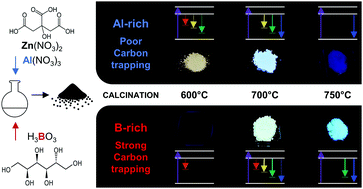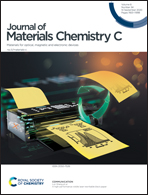Rare-earth-free zinc aluminium borate white phosphors for LED lighting†
Abstract
The use of rare-earth elements (Y, Ce, Eu…) in commercial phosphor-converted white light-emitting diodes (pc-WLEDs) raises environmental and geopolitical concerns. Lanthanide-free white emitting phosphors based on amorphous yttrium aluminium borate (YAB) have previously been synthesized by the polymeric precursor (PP) method, showing high internal quantum yields (iQY) and a broad emission band in the visible range. However, yttrium has still been largely present in the amorphous YAB matrix. Here we synthesize zinc aluminium borate (ZAB) powder by the PP method, a novel family of rare-earth-free phosphors producing broad and intense photoluminescence emissions when excited by near-UV from 300 to 400 nm, with high iQYs up to 60%. The photoluminescence band is easily tuneable in the visible range of the electromagnetic spectrum, from warm- to cold-white emissions by adjusting either the precursor ratio or the calcination temperature used to prepare the ZAB powders. Finally, we report spectroscopic arguments that reinforce the hypothesis of the molecular origin of the photoluminescence in ZAB phosphors. Our results demonstrate the essential role of the composition (Al/B ratio) and thermal treatment in the transformation and trapping of carbonaceous species (i.e. black carbon or luminescent molecular species) in an amorphous ZAB matrix. This efficient family of phosphors only composed of abundant and non-toxic elements opens the way for the integration of rare-earth-free single phosphors synthesized by wet chemistry into WLED lighting devices.



 Please wait while we load your content...
Please wait while we load your content...